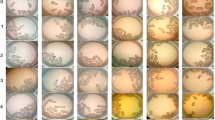Abstract
Taenia crassiceps cysticerci are used as experimental model to study the host-parasite relationship and treatment of cysticercosis. One of the described mode of actions of nitazoxanide (NTZ) is to block the pyruvate ferredoxine oxidoreductase (PFOR) enzyme which is an essential enzyme to the parasite metabolism. The aim of this study was to determine the in vivo influence of one dosage of NTZ on the energetic metabolism of T. crassiceps cysticerci. Thirty days after the intraperitoneal inoculation of T. crassiceps cysticerci, BALB/c mice were orally treated with 7.5 mg/kg of NTZ. The control group was treated with physiologic solution (NaCl 0.9%). After 24 h, the animals were euthanized and the cysticerci were removed, washed, and processed for biochemical analysis. The organic acids detection occurred through high-performance liquid chromatographic and spectrophotometric analysis. While there was no difference in the glucose dosages, it was possible to observe a significant increase in the lactate concentrations and a decrease in the pyruvate concentrations of the NTZ-treated groups when compared to the control group. Also, there was a decrease in the urea and alpha-ketoglutarate concentrations. This probably occurred due to the impairment of the parasite’s PFOR and nitroreductases leading an impairment of the mitochondrial aerobic pathways. In conclusion, the in vivo NTZ treatment leads to an increase in the lactic fermentation and to a decrease in the protein catabolism in T. crassiceps cysticerci.
Similar content being viewed by others
References
Anderson VR, Curran MP (2007) Nitazoxanide. Drugs. https://doi.org/10.2165/00003495-200767130-00015
Cabada MM, Lopez M, Arque E, White AC (2014) Prevalence of soil-transmitted helminths after mass albendazole administration in an indigenous community of the Manu jungle in Peru. Pathog Glob Health. https://doi.org/10.1179/2047773214Y.0000000142
Fox LM, Saravolatz LD (2005) Nitazoxanide: a new thiazolide antiparasitic agent. Clin Infect Dis. https://doi.org/10.1086/428839
Fraga CM, Costa TL, Bezerra JCB, Lino Junior RS, Vinaud MC (2012) Taenia crassiceps: host treatment alters glycolisis and tricarboxilic acid cycle in cysticerci. Exp Parasitol. https://doi.org/10.1016/j.exppara.2011.11.001
Fraga CM, da Costa TL, de Castro AM, Reynoso-Ducoing O, Ambrosio J, Hernández-Campos A, Castillo R, Vinaud MC (2017) A benzimidazole derivative (RCB20) in vitro induces an activation of energetic pathways on Taenia crassiceps (ORF strain) cysticerci. Exp Parasitol. https://doi.org/10.1016/j.exppara.2016.11.002
Freitas AA, Moura VB, Irusta VR, Vinaud MC, Oliveira MA, Lino-Júnior RS (2016) IFN-gamma role in granuloma formation in experimental subcutaneous cysticercosis. Exp Parasitol. https://doi.org/10.1016/j.exppara.2016.06.004
Garcia HH, Nash TE, Del Brutto OH (2014) Clinical symptoms, diagnosis, and treatment of neurocysticercosis. Lancet Neurol. https://doi.org/10.1016/S1474-4422(14)70094-8
Gilles HM, Hoffman PS (2002) Treatment of intestinal parasitic infections: a review of nitazoxanide. Trends Parasitol. https://doi.org/10.1016/S1471-4922(01)02205-X
Hotez PJ (2009) Mass drug administration and integrated control for the world’s high-prevalence neglected tropical diseases. Clin Pharmacol Ther. https://doi.org/10.1038/clpt.2009.16
Isac E, de A Picanço G, da Costa TL, de Lima NF, de S M M Alves D, Fraga CM, de S Lino Junior R, Vinaud MC (2016) Nitazoxanide induces in vitro metabolic acidosis in Taenia crassiceps cysticerci. Exp Parasitol. https://doi.org/10.1016/j.exppara.2016.10.012
Matos-Silva H, Reciputti BP, Paula EC, Oliveira AL, Moura VBL, Vinaud MC, Oliveira MAP, Lino-Junior RS (2012) Experimental encephalitis caused by Taenia crassiceps cysticerci in mice. Arq Neuropsiquiatr. https://doi.org/10.1590/S0004-282X2012005000010
Muller J, Schildknecht P, Muller N (2013) Metabolism of nitro drugs metronidazole and nitazoxanide in Giardia lamblia: characterization of a novel nitroreductase (GlNR2). J Antimicrob Chemother. https://doi.org/10.1093/jac/dkt106
Palomares-Alonso F, Piliado JC, Palencia G, Ortiz-Plata A, Jung-Cook H (2007) Efficacy of nitazoxanide, tizoxanide and tizoxanide/albendazole sulphoxide combination against Taenia crassiceps cysts. J Antimicrob Chemother. https://doi.org/10.1093/jac/dkl463
Rendón JL, Del Arenal IP, Guevara-Flores A, Uribe A, Mendoza-Hernández G (2004) Purification, characterization and kinetic properties of the multifunctional thioredoxin-glutathione reductase from Taenia crassiceps metacestode (cysticerci). Mol Biochem Parasitol. https://doi.org/10.1016/j.molbiopara.2003.09.003
Sciutto E, Fragoso G, Larralde C (2011) Taenia crassiceps as a model for Taenia solium and the S3Pvac vaccine. Parasite Immunol. https://doi.org/10.1111/j.1365-3024.2010.01257.x
Secor WE, Montgomery SP (2015) Something old, something new: is praziquantel enough for schistosomiasis control? Future Med Chem. https://doi.org/10.4155/fmc.15.9
Silva GB, Nunes DS, de Sousa JE, Gonçalves-Pires MD, Levenhagen MA, Costa-Cruz JM (2017) Antigenic fractions from Taenia crassiceps metacestodes obtained by hydrophobicity for the immunodiagnosis of active and inactive forms of neurocysticercosis in human cerebrospinal fluid samples. Parasitol Int. https://doi.org/10.1016/j.parint.2016.12.009
Tielens AGM, van den Heuvel JM, van den Bergh SG (1984) The energy metabolism of Fasciola hepatica during its development in the final host. Mol Biochem Parasitol 13:301–307
Vaz AJ, Nunes CM, Piazza RM, Livramento JA, da Silva MV, Nakamura PM (1997) Immunoblot with cerebroespinal fluid from patients with neurocysticercosis using antigen from cysticerci of Taenia solium and Taenia crassiceps. Am J Trop Med Hyg 57:354–357
Vinaud MC, Lino Junior RS, Bezerra JCB (2007) Taenia crassiceps organic acids detected in cysticerci. Exp Parasitol. https://doi.org/10.1016/j.exppara.2007.01.013
Vinaud MC, Ferreira CS, Junior RSL, Bezerra JCB (2008) Taenia crassiceps: energetic and respiratory metabolism from cysticerci. Exp Parasitol. https://doi.org/10.1016/j.exppara.2008.07.008
Walker M, Rossignol JF, Torgerson P, Hemphill A (2004) In vitro effects of nitazoxanide on Echinococcus granulosus protoscoleces and metacestodes. J Antimicrob Chemother. https://doi.org/10.1093/jac/dkh386
White AC Jr (2003) Nitazoxanide: an important advance in anti-parasitic therapy. Am J Trop Med Hyg. https://doi.org/10.4269/ajtmh.2003.68.382
Wright SG (2012) Protozoans infections of the gastrointestinal tract. Infect Dis Clin N Am. https://doi.org/10.1016/j.idc.2012.03.009
Acknowledgements
The authors would like to thank the National Counsel of Technological and Scientific Development (CNPq) for the financial support, grant numbers 471009/2013-0 and 302159/2016-9.
Author information
Authors and Affiliations
Corresponding author
Rights and permissions
About this article
Cite this article
Nasareth, J.M., Fraga, C.M., Lima, N.F. et al. In vivo treatment with nitazoxanide induces anaerobic metabolism in experimental intraperitoneal cysticercosis. Parasitol Res 116, 3037–3041 (2017). https://doi.org/10.1007/s00436-017-5614-8
Received:
Accepted:
Published:
Issue Date:
DOI: https://doi.org/10.1007/s00436-017-5614-8




